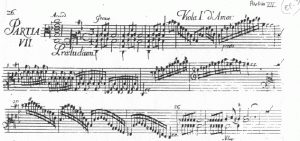Welcome to our forum. A Message To Our New and Prospective Members . Check out our Forum Rules. Lets keep this forum an enjoyable place to visit.
Currently working on errors from the latest (SimplePress) forum update. Many issues have been resoled and others are being worked on. Thank you for your patience.
 Topic RSS
Topic RSS



 (0 votes)
(0 votes) Regulars
 Offline
Offline








I read the extract from The Strad's June 2003 issue, where Pauline Nobes delves into the history and purpose of scordatura from the 17th-century onwards - pretty interesting!
The sound of the instrument is transformed by the retuning, with the extent and type of change dependent upon the tuning required. Even passages which are playable with standard tuning may be transcribed into various scordaturas purely for the effect on timbre. The most prolific period of composition involving scordatura was the second half of the 17th-century, particularly among the Bohemian and Austro-German violinist-composers, and even though at this time it was recommended only for the ‘masters’, the diversity of music embraced by scordatura is, in fact, remarkably wide.
Read the rest of the extract at The Strad:
Open To Change: a History of Scordatura
Here's a few short examples of Scordatura in Baroque music AND BEYOND!
Biber's 15 Mystery (Rosary) Sonata's each had different tunings!!!
Scordatura tuning for the 12th Mystery Sonata - The Ascension II. Allemanda - C, E, G, C tuning.
Y'all might find this snappy way of changing over to G, G, D, D tuning interesting!
🤔... wonder if this type of crossing the strings might have other applications.
NOW, here's an album for the pure joy of listening to Baroque pieces using scordatura - played by violinist Mayumi Hirasaki:
L'arte della scordatura (The Art of Detuning): Violin Works from Biber to Tartini (34 pieces!)
The LIVE PERFORMANCE - Mayumi switches between 2 differently tuned violins!
...check out this related thread!
Regulars
 Offline
Offline








I thinks it's pretty cool that Biber's compositions using scordatura was not only of interest to Classical violinists, but also influenced at least one Fiddler!
Nils Økland is a Norwegian Hardanger Fiddler who plays contemporary AND folk music. He talks a little about Biber and then plays one of his own compositions, "Biberslått". "A 'gangar', (a South-Norwegian dance in 2/4), but in the style of Biber".
Check out more discussions on scordatura used in Nordic tunes in this thread:
Regulars
 Offline
Offline








As shown in the OP video by Andrew Manze, Scordatura Notation makes reading music easy! It 1st shows the open string tuning (as a column of notes) & then it just uses standard notation finger placement - you just have to disregard or get used to the different pitch you hear.
I've been listening to more Baroque music lately - especially played by the Viol family & Viola d'Amore. They were popular extended string instruments of this time and from what I've read so far, the Viola d'Amore was expected to tune to each piece until the end of the 18th Century, when the standard became an 'open D' tuning (A, d, a, d', f♯', a', d"). Not sure if the Viol family changed tuning that often... I get the impression they didn't.
Anyway, back to Biber's obsession with Scordatura in the OP...
I found he had a different way of notating for 6-string instruments!
In Biber's Harmonia Artificiosa no. VII, a different version of scordatura notation is used. Biber uses a nine line staff. The clefs used are based on alto clef (imagining that you are playing a viola). The piece is written for a six-stringed instrument. The upper part of the staff supposes that you are playing on the upper four strings and the lower part that you are playing on the lower four strings (still imagining that you are reading the four strings of a viola in alto clef). This does mean that there are two ways of notating notes on the middle two strings but it quickly becomes apparent, when playing, what the correct reading should be. (Wikipedia)
This is a pretty amazing 'extended Alto Clef' staff & answers questions I had when starting to learn on 5-strings (like 'why not')! 🤗
🤔... but I think a heavy/bold mid-line would help make reading the lower strings MUCH easier!
Check out the Super Violas - Edgar's Strange Cousins! Thread
1 Guest(s)


 Log In
Log In Register
Register








